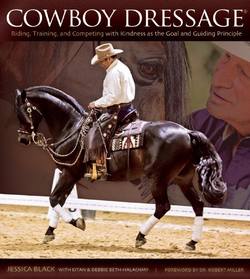Читать книгу Cowboy Dressage - Jessica Black - Страница 20
На сайте Литреса книга снята с продажи.
CHAPTER TWO
PHILOSOPHY
ОглавлениеHorse training is an art, not a science, Eitan insists. A horse-person paints the picture of the perfect horse in her mind’s eye. Then she sets out to work with the horse she has in front of her, molding him to fit that picture.
Of course, the painting is never finished, because it changes and adapts as the horse develops. No horse is ever finished. The horseperson’s art lies in the ability to see the potential in a horse, and to foster the rider-horse partnership that will allow both to work toward that potential.
2.1 – Horsemanship is an art, Eitan explains. You choose a blank canvas, and start adding colors. If you have the artistic vision of a true horseperson, you look at a horse, see what he is comfortable with and what he is going to be, and you start painting. You add each layer, bit by bit and step by step, sometimes adjusting your inner vision to the new reality of your canvas. Slowly, very slowly, the picture that began as a dream in your mind begins to emerge on the canvas.
The better a horse gets, the more idealistic the picture you hold of him in your mind. You add to the original, change it when you realize that perhaps when you drew on the blank canvas you were thinking of some other horse, not the one you are getting to know better each day. The horse you are working with will change; he will change the rider, as well, and that perfect picture, that never-reached goal, will become more and more beautiful. But, never finished. Every time you ride, you create art; art is movement made from the partnership between horse and rider (fig. 2.2).
2.2 – “The art of riding can only be found between horse and rider.” (Eitan Beth-Halachmy) Every moment horse and rider spend together contributes to their partnership, and the benefits of a carefully forged relationship will be seen in everything they do, from the show ring to the trail. Here, Eitan and Cheyenne Gold enjoy the freedom and relaxation of the countryside.
Debbie is always quick to say, “Eitan is the artist. The rest of us make it possible for him to do his art, and to share it with as many people as possible.” Before Cowboy Dressage, before the felicitous meeting of Deb and Eitan and his union with Holiday Compadre, Eitan already had a mental picture of that perfect horse. He had come to the United States from Vienna, Austria, with visions of cowboys and the Old West, and he had sought to meld the Western tradition with his knowledge of classical dressage. When Compadre responded so well to his method and began winning ribbons and hearts, the art was clear for all to see. As people began to learn about and do Cowboy Dressage, they too became artists: everyday they paint their own pictures, and work with their horses toward achieving that goal.
